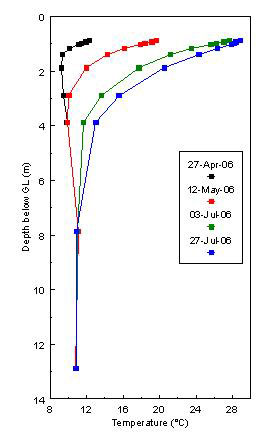Energy Storage: holy grail of the renewables industry
Electricity storage has been described as the holy grail of the renewables industry. It is very difficult and expensive to store electricity, so every effort is made to provide electricity at the time it is needed. PV cells only generate electricity by day, and so cannot be used to meet lighting demands at night. Turbines generate electricity when the wind blows, but this does not often match times of peak demand. The problem is huge and rewards for solving it will be very large.
There is an equivalent problem with heat storage. There is plenty of surplus heat on summer days, but the peak demand for heating comes on winter nights. For this reason Seasonal Thermal Energy Storage has also been described as the holy grail of the renewables industry, or the lack of it as the Achilles Heel of renewable energy.
On site heat storage can now be achieved using Interseasonal Heat Transfer of which the key element is the ThermalBank.

Thermal Energy Storage – Seasonal Thermal Energy Storage
Thermal Energy Storage is the key to doubling the Coefficient of Performance of Ground Source Heat Pumps. ICAX uses ThermalBanks to store heat energy from one season to another by exploiting the thermal inertia of the ground: heat only moves very slowly through the ground.
A ThermalBank is a bank of earth used to store heat energy collected in the summer for use in winter to heat buildings. A Thermal Bank is an integral part of an Interseasonal Heat Transfer system invented, developed and patented by ICAX to answer the need for on site renewable energy without burning fossil fuels.
ThermalBank: a large volume of warm ground
A Thermal Bank is used to store warm temperatures over a very large volume of earth for a period of months, as distinct from a standard heat store which can hold a high temperature for a short time in an insulated tank.
It is a characteristic of earth that heat only moves very slowly through it – as slowly as one metre a month. ICAX has discovered how to input surplus heat into the ground over the summer months and extract that heat over the winter months for use in the space heating of buildings.
Interseasonal Heat Transfer works by capturing heat energy from the sun via a collection pipe network just beneath the surface of black tarmac roads (or car parks or school playgrounds). It then stores the energy in computer-controlled Thermal Banks in the ground under the foundation of buildings, and releases it to heat the buildings in winter via heat pumps linked to underfloor heating.
The temperature of the ground at a depth of seven metres in the UK will normally be very close to 10°C – the temperature will vary very little between summer and winter as heat only moves very slowly in the ground. ICAX uses this characteristic of the ground to store heat from summer to winter. Using fluid – in an array of pipes – as the transport mechanism solves the difficulty of getting the heat into the ground – and out again.
The way in which heat is absorbed and released by the ground is complex and required to be studied using complex iterative methods that have only become practical with the use of computational fluid dynamics (“CFD”). The computer models developed by ICAX have since been tested in practical installations and refined to reflect empirical results. These have been used to refine the design parameters for successful ThermalBanks.
Black surfaces absorb heat
Tarmac roads tend to absorb the heat of the sun up to the point when they radiate heat as quickly as they are absorbing it: the surface temperature of tarmac can often reach 15°C higher than the ambient air temperature. ICAX collects heat using water circulating through an array of pipes embedded in the surface of the tarmac and deposits it in ThermalBanks constructed beneath the insulated foundation of buildings. The temperature across the ThermalBank can be increased from its natural temperature of 10°C to over 25°C in the course of the summer months.
ICAX uses a ground source heat pump to extract heat from the ThermalBank when it is needed to heat the building in winter. Unlike a normal ground source heat pump which typically starts with an autumn ground temperature of 10°C the heat pump in an Interseasonal Heat Transfer system starts with a temperature of over 25°C from the ThermalBank.

Borehole Thermal Energy Storage – BTES
Borehole thermal energy storage can be used to provide a ThermalBank. This alternative construction is used for retrofits where the ground beneath the building is not accessible, but it does incur the cost of drilling a borehole field.
Solar Thermal Energy Storage – STES
Because the energy for Seasonal Thermal Energy Storage comes from the sun it is also referred to as Solar Thermal Energy Storage. "Interseasonal geothermal store" has also been used to describe a ThermalBank. The term "Solar Recharge" is also used to describe solar capture and storage of heat in the ground after ground temperatures have been depleted by ground source heat pumps.
Double the CoP of an unassisted ground source heat pump
Using a heat charged ThermalBank doubles the Coefficient of Performance of a ground source heat pump and allows an 80% saving of carbon emissions compared to providing heat from a gas boiler.
See also: Renewable Heat
See also: Renewable Cooling
See also: Banking on IHT
See also: Seasonal Heat Storage
See also: Aquifer Thermal Energy Storage
See also: Borehole Thermal Energy Storage
See also: Underground Thermal Energy Storage
ICAX provides Seasonal Thermal Energy Storage without the complications and expense of involving phase change materials.



